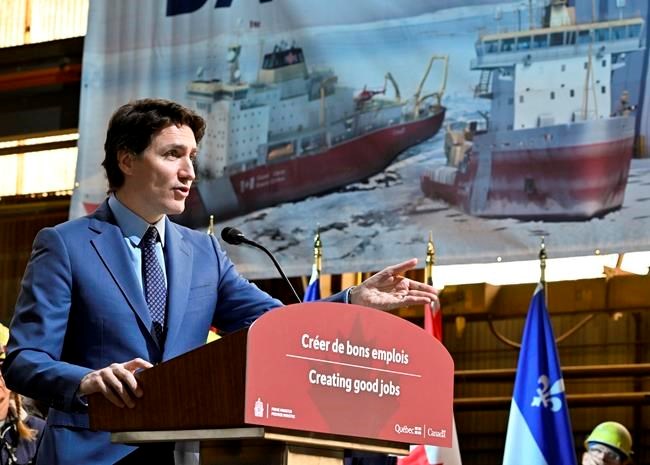OTTAWA — The federal government doesn't know when replacements for Canada's aging icebreakers will start to arrive, as officials say the schedule will ultimately depend on a fresh set of negotiations with Quebec shipyard Chantier Davie.
Prime Minister Justin Trudeau announced last week that Davie was being formally tapped to build seven icebreakers for the Canadian Coast Guard in the coming years at an estimated cost of $8.5 billion.
Yet despite long-standing concerns about the Coast Guard's existing icebreakers and calls for urgency to ensure replacements arrive in time, the announcement was devoid of any specific timelines.
In response to questions from The Canadian Press, Procurement Department spokeswoman Michele LaRose said new negotiations have been launched to hammer out contracts for each of the seven vessels.
Among the issues under discussion: When Davie will actually deliver the vessels.
"Negotiations have begun with Chantier Davie on contracts to support the construction of six program icebreakers and one polar icebreaker for the Canadian Coast Guard," LaRose said in an email.
"With respect to timelines and costs, the exact build schedule and cost will be negotiated and finalized during the individual contract negotiations."
LaRose did not indicate when the government hopes to have those contracts finished.
Last week's announcement followed three years of negotiations over what investments Davie would be required to make as a condition of getting the icebreaker work.
Officials had originally hoped to conclude those talks by the end of 2020, and opened the door at one point to abandoning the discussions with Davie and looking at other options.
The lack of timelines did not sit well with University of Calgary professor Rob Huebert, an expert on the Arctic and Coast Guard, who said building new icebreakers is time consuming even without the added complication of negotiations.
"It's difficult because you've got to get the engineering down," he said. "You are purposely driving into ice. I mean, remember what happened to the Titanic when it accidentally hit some ice."
Auditor general Karen Hogan noted in a report last year that the Coast Guard's existing fleet is already on average more than 40 years old, increasingly prone to breakdowns and expensive to maintain.
Hogan found that the federal government was in the process of spending hundreds of millions of dollars to extend the life of the fleet, including its 54-year-old flagship, the CCGS Louis S. St-Laurent.
She also noted that the government had recently purchased three second-hand icebreakers from Davie, which would help backstop the current fleet.
But the auditor general concluded there was little room for delay if Ottawa wanted to maintain its current icebreaking capabilities, which are critical for keeping Canada's waterways open to trade and resupplying northern communities.
An internal Coast Guard report obtained by The Canadian Press in 2019 indicated the fleet was already having problems, including $2 million in lost navigational buoys, disrupted ferry services in Eastern Canada and commercial ships being trapped in ice.
Davie, which is owned by a company based in Monaco, also has a mixed record when it comes to making good on the federal contracts it has won in recent years, including the three second-hand icebreakers.
Originally ordered in August 2018, the last of the three Norwegian-built icebreakers was only delivered by Davie late last year. By that point, the cost to Canadian taxpayers had soared from $610 million to nearly $1 billion.
The shipyard was also selected through a sole-sourced deal in 2019 to build two ferries for Transport Canada to replace two existing vessels serving Eastern Canada.
Officials said at the time that they expected the first vessel to be delivered by 2026, but that has since been delayed to 2028 even though one of the existing ferries was lost to a fire last year.
This report by The Canadian Press was first published April 10, 2023.
Lee Berthiaume, The Canadian Press



